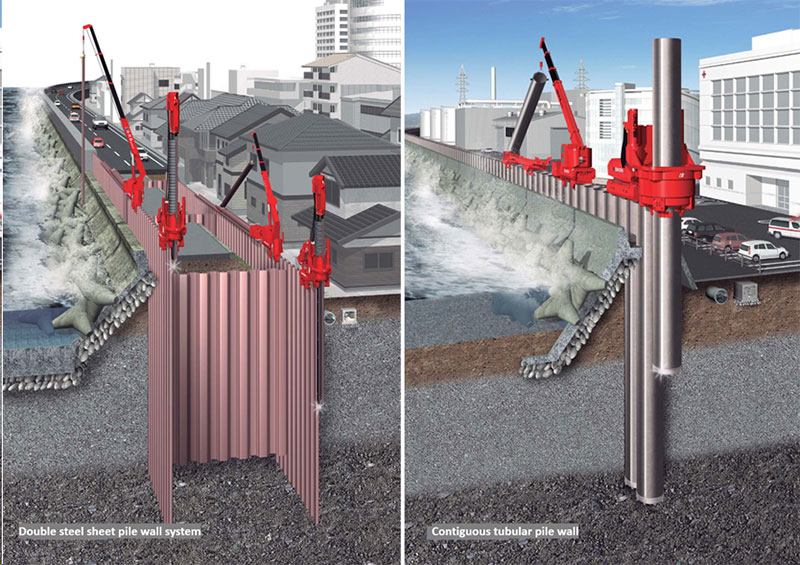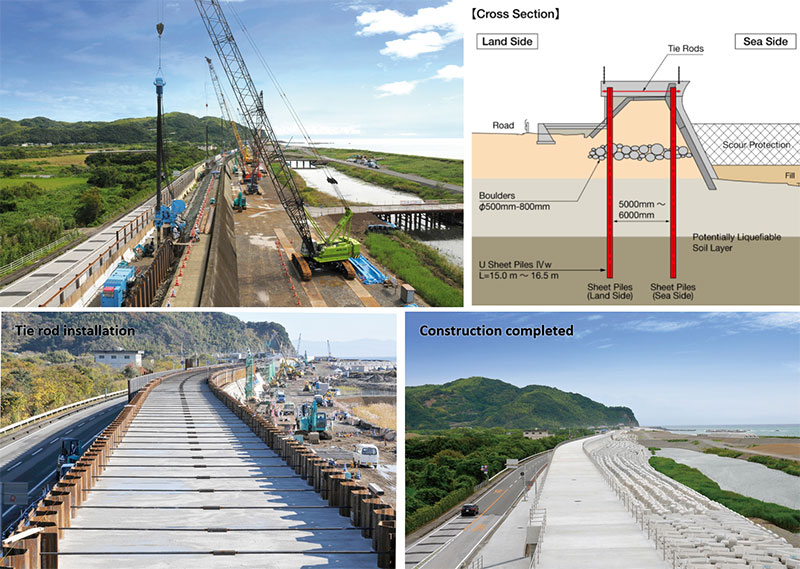Implant Levee
GIKEN LTD.
| Publication date | May 28, 2021 (Posted on March 14, 2022) |
|---|---|
| Sector | Natural Disasters / Coastal Areas |
Company Overview

GIKEN invented the world’s first reaction-based hydraulic pile jacking machine, named “SILENT PILER™”, which generates neither vibration nor noise. We have developed machines and construction methods that have minimal impact on the environment since its foundation in 1967.
In recent years, GIKEN has been putting effort into having the “Implant Method™” adopted widely. The method is a construction method that involves the piles deeply embedded into the ground forming a contiguous wall. The piles are supported by the ground to create a robust and resilient “Implant structure™.” The Implant structure can be applied to levees, retaining walls, and bridge foundations as disaster prevention and mitigation infrastructure, contributing to the protection of human life and property from disasters.
Climate Change Impacts
Natural disasters such as storm surges and floods caused by typhoons and torrential rains, and tsunamis caused by earthquakes, are getting more frequent around the world with enormous human and economic damages. Although levees play an important role in protecting people’s lives and property from disasters, many of them have foundation that fails or slopes that slip when being subjected to large external forces. Moreover, many cases in which earthen embankments burst due to heavy rain have been reported.
Adaptation Initiatives
The “Implant Levee™“ consists of robust and durable structural members which are deeply embedded into the ground. Because the levee is supported by the ground, it is solid and strong against large external forces such as earthquakes, tsunami, and floods (Fig.1). The Implant Levee also prevents its breaches due to liquefaction and ground subsidence, and it can maintain the function even when the body is partially damaged due to a disaster (Fig.2).
Other than that, all press-in machinery and equipment work on top of the installed piles, temporary platforms are no longer required, and it is possible to carry out time- and space- saving operation (Fig.3).
Application: The canal ring of Amsterdam, the Netherlands (Fig.4)
The canal ring in Amsterdam, which is on the World Heritage Sites list, has been collapsing due to the corrosion of wooden piles and erosion, while there are concerns about the impact of the renovation work on the surrounding environment, traffic flow and landscape. However, if the “Gyropress Method™”, which allows piles to be installed directly into existing revetment, and the “GRB™ System”, which allows machines to self-move on top of the installed piles are adopted, temporary revetment and temporary piers are no longer required. In recognition of the fact that these methods will have the minimal impact on the surrounding environments and landscape, GIKEN entered into the partnership agreement with the city of Amsterdam.
Effects / Expected Benefits
By constructing the Implant Levee (or reinforcing the existing levee) along the coastline that are expected to be damaged when storm surges, floods, or tsunamis occur, it will prevent the levee from collapsing. Thus, it makes a significant contribution to protecting people’s lives and property from disasters. In the event of a disaster, the levee can be used as an emergency transport route or as a base for pumper trucks to operate drainage work by installing temporary covering plates on the piles. Thus, it can contribute to the early recovery of the disaster-affected area. In addition, because of its time- and space-saving construction, the work emits less CO2 than other construction methods that require temporary platforms.





